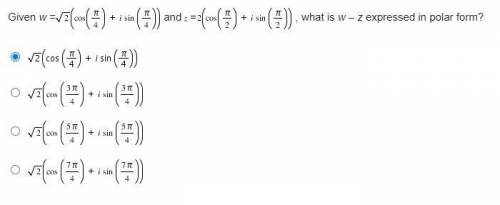
Mathematics, 19.01.2021 02:30 nikkiwoodward1ovgszp
Given w =StartRoot 2 EndRoot (cosine (StartFraction pi Over 4 EndFraction) + I sine (StartFraction pi Over 4 EndFraction) ) and z = 2 (cosine (StartFraction pi Over 2 EndFraction) + I sine (StartFraction pi Over 2 EndFraction) ) , what is w – z expressed in polar form?
StartRoot 2 EndRoot (cosine (StartFRaction pi Over 4 EndFraction) + I sine (StartFraction pi Over 4 EndFraction) )
StartRoot 2 EndRoot (cosine (StartFraction 3 pi Over 4 EndFraction) + I sine (StartFraction 3 pi Over 4 EndFraction) )
StartRoot 2 EndRoot (cosine (StartFraction 5 pi Over 4 EndFraction) + I sine (StartFraction 5 pi Over 4 EndFraction) )
StartRoot 2 EndRoot (cosine (StartFraction 7 pi Over 4 EndFraction) + I sine (StartFraction 7 pi Over 4 EndFraction) )


Answers: 2


Other questions on the subject: Mathematics

Mathematics, 21.06.2019 20:30, jmcd10
Create a question with this scenario you could ask that could be answered only by graphing or using logarithm. david estimated he had about 20 fish in his pond. a year later, there were about 1.5 times as many fish. the year after that, the number of fish increased by a factor of 1.5 again. the number of fish is modeled by f(x)=20(1.5)^x.
Answers: 1

Mathematics, 21.06.2019 21:30, gonzalezashley152
In a test for esp (extrasensory perception), the experimenter looks at cards that are hidden from the subject. each card contains either a star, a circle, a wave, a cross or a square.(five shapes) as the experimenter looks at each of 20 cards in turn, the subject names the shape on the card. when the esp study described above discovers a subject whose performance appears to be better than guessing, the study continues at greater length. the experimenter looks at many cards bearing one of five shapes (star, square, circle, wave, and cross) in an order determined by random numbers. the subject cannot see the experimenter as he looks at each card in turn, in order to avoid any possible nonverbal clues. the answers of a subject who does not have esp should be independent observations, each with probability 1/5 of success. we record 1000 attempts. which of the following assumptions must be met in order to solve this problem? it's reasonable to assume normality 0.8(1000), 0.2(1000)%30 approximately normal 0.8(1000), 0.2(1000)% 10 approximately normal srs it is reasonable to assume the total number of cards is over 10,000 it is reasonable to assume the total number of cards is over 1000
Answers: 1

Mathematics, 21.06.2019 22:00, jamarstand
What is the equation of the line that is parallel to the line with the equation y= -3/4x +1 and passes through the point (12,-12)
Answers: 1

You know the right answer?
Given w =StartRoot 2 EndRoot (cosine (StartFraction pi Over 4 EndFraction) + I sine (StartFraction p...
Questions in other subjects:



English, 18.03.2021 03:20



Physics, 18.03.2021 03:20



Mathematics, 18.03.2021 03:20




